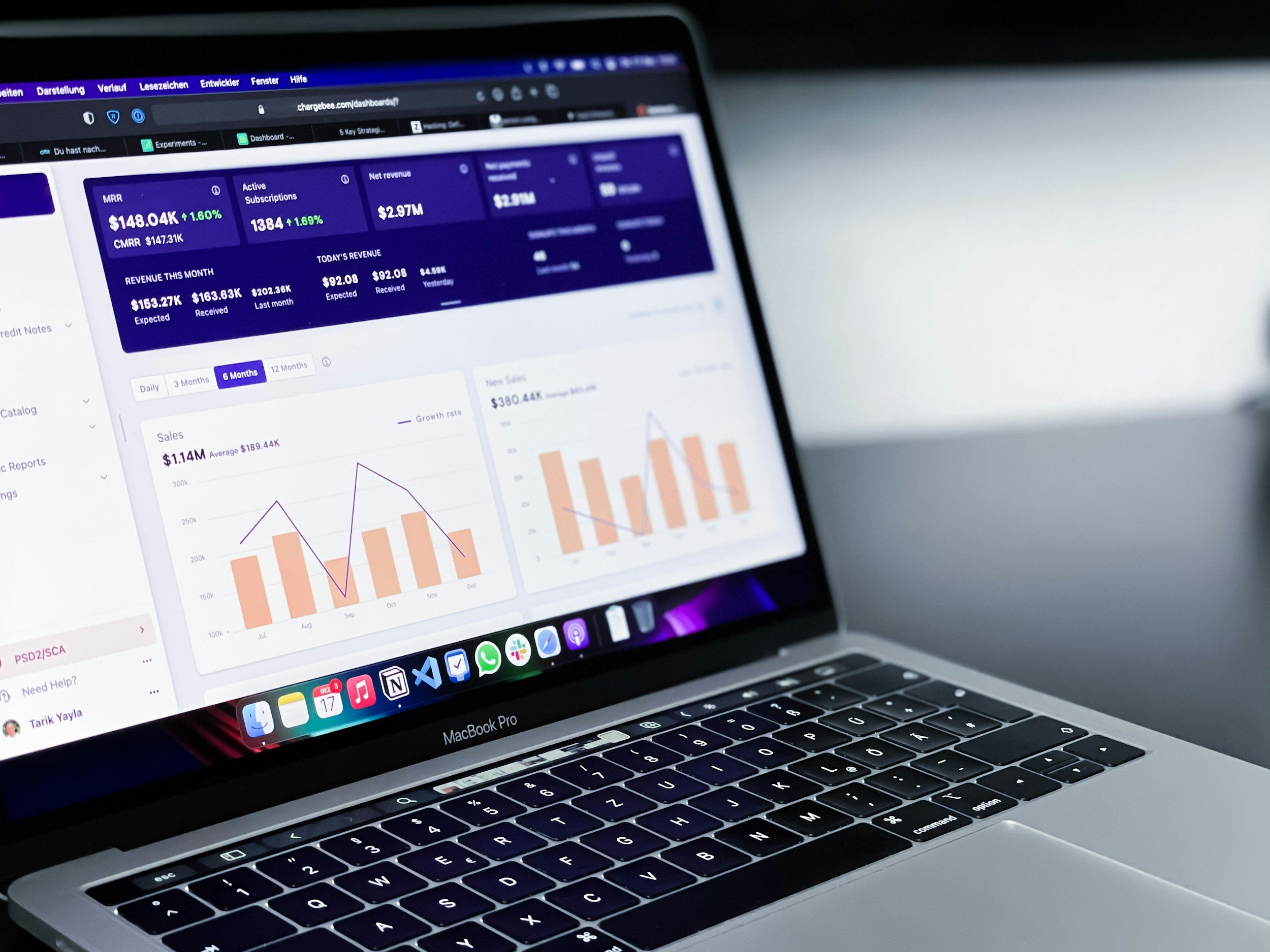In today's fast-paced business world, data has become a critical asset. However, these assets often lie unutilised and meaningless without context and compelling storytelling. When properly presented, data comes to life and becomes a total game-changer. We've previously discussed data messaging in our blog, which enables the effective presentation of your data to your audience.
Companies, including boards and trustees, are increasingly reliant on this information and its presentation for data-driven decision-making. Therefore, it's essential to find ways to visualise and interpret the vast amounts of information generated by the ever-increasing use of digital technologies. This data visualisation often takes the form of dashboards, a tool that has long been the cornerstone of business intelligence. Dashboards provide a centralised platform to view key metrics and indicators at a glance, and in near real-time. However, as the volume and complexity of data increase, it's clear that dashboards, while still valuable, are not enough on their own to drive deeper insights and more informed decisions. This has led to the evolution of the concept of "beyond dashboards," an expansion in how organisations approach data visualisation and decision-making. Companies are constantly looking for ways to stay ahead of their competitors and are evaluating methods to enhance and enrich their dashboards to go beyond traditional metric projections.
The Limitations of Traditional Dashboards
Dashboards have long been a staple of data analytics, providing a visual summary of key performance indicators (KPIs) and metrics. While they offer immediate insights and facilitate monitoring and discussions, they come with inherent limitations:
Static Nature: Traditional dashboards typically provide a snapshot of data at a given point in time. The definition, design, and placement of the metrics are often static. As a result, they can fail to offer the depth of analysis needed for dynamic decision-making or evolving trends.
Over-Simplification: In an attempt to simplify information for quick consumption, dashboards often omit context, or context is dependent on the designer's understanding of the audience, which can lead to data misinterpretation.
Limited Interactivity: Traditional dashboards have limited interactivity. Users often need to delve deeper into the data, but this is restricted by the features of the tool used. This can mean switching between different tools, creating multiple reports, or utilizing features not suited for the intended message, resulting in friction and a poor user experience.
Data Overload: Trying to mitigate the static nature of traditional dashboards often leads to congested displays, resulting in confusion or analysis paralysis. Users can be overwhelmed with information that is not immediately actionable or, worse, unused. This results in wasted effort, inefficient practices, technical debt, and a frustrated audience.
Message Duplication: Information is relevant according to the context in which it is displayed. Often, the same information serves different audiences with differing contexts. This results in creating similar information with slightly different contexts, increasing confusion and reducing clarity among users.
These shortcomings highlight the need for a more evolved approach to data visualisation and analysis — one that goes beyond static dashboards.
Are you experiencing these limitations with your current dashboards? Ei Square offers expert consultations to help you move beyond static visualisations and unlock the true potential of your data.
Contact us today to discuss how we can transform your data strategy.
The Shift Toward Advanced Analytics
The future of data visualisation lies in advanced analytics tools and methods that go beyond the traditional dashboard. Organisations are moving toward more sophisticated, dynamic, and interactive ways to explore data, uncover data insights, and make data-driven decisions. With the release of OpenAI and generative AI technology, organisations are looking to harness this to help audiences interact with data like never before.
Some of the features of what "beyond dashboards" offers are:
Predictive Analytics: One of the most significant developments beyond dashboards is predictive analytics. Organisations are exploring effective use cases to implement predictive analytics. Using machine learning algorithms and statistical models, businesses can forecast future trends and outcomes. Instead of simply viewing historical data, decision-makers can access data-driven projections, allowing for more proactive strategies. Forecasting is not a new concept; however, predictive analytics applies to a wide range of use cases, and the data input for those use cases can be wider, incorporating both external and internal data points of an organisation.
Automated Insights: With the rise of AI and machine learning, businesses can now receive automated insights, reducing the need for manual report generation. With features like natural language processing (NLP) and decision intelligence tools, users can create and join information even for very complex datasets. These insights are not just numbers; they can be contextualized and presented in natural language, making them easier for non-technical users to understand. For example, an automated insight might say, "Sales in the Southeast region are projected to drop by 10% next quarter, primarily due to a decrease in customer retention."
Augmented Analytics: Augmented analytics is an emerging trend that integrates artificial intelligence into data analytics tools. It automatically analyzes data patterns and provides recommendations, insights, or action plans. This process goes beyond dashboards by offering prescriptive advice that empowers users to act based on predictive outcomes. For instance, rather than simply showing a decrease in customer satisfaction, augmented analytics might suggest potential reasons for the drop and actions that could mitigate the problem. This captures the essence of the final maturity level in Gartner’s analytics value escalator.
Natural Language Processing (NLP): NLP enables users to ask questions and receive answers in a natural language format. Platforms such as chatbots or voice interfaces allow users to interact with data more intuitively. Instead of manually adjusting filters on a dashboard, users can simply ask, “What were the sales figures for last quarter?” or “What’s the forecast for next year’s growth?” This technology also helps to bring out the sentiment of the users in a way that gives deeper meaning to the insights that was either impossible or difficult with traditional methods.
Data Storytelling: Effective data storytelling is an essential aspect of going beyond dashboards. Data doesn’t just need to be presented; it needs to be communicated in a way that resonates with the audience. Data storytelling weaves together numbers and narrative to provide context, insights, and implications in a compelling way. Rather than just offering raw data points, data storytelling uses visuals, contextual information, and trends to craft a narrative that drives action.
Immersive Visualisation: As immersive technologies like augmented reality (AR) and virtual reality (VR) evolve, the possibility of using these mediums for data visualisation expands. AR and VR can provide 3D visualizations that help users interact with data in a spatial, more intuitive manner. For example, a company might use a VR environment to explore geographic data or a 3D model of a product, providing deeper engagement and understanding. Drone technology use has continued to rise during and post-COVID when roof leaks, plumbing, etc., still needed to be fixed, and this, with the VR technology use in insights, has proven that this technology could be used to gain access to areas much more difficult to navigate in person.
Ready to move beyond static dashboards and harness the power of predictive analytics, automated insights, and AI-driven data storytelling? Ei Square specializes in helping organisations implement advanced analytics solutions that drive actionable insights and strategic decision-making.
Contact us today for a consultation and discover how we can transform your data into a competitive advantage.
The Future: A Personalised, Adaptive Data Experience
Looking forward, the evolution beyond traditional dashboards is driving a significant shift towards personalised, adaptive data experiences. As artificial intelligence and machine learning technologies advance, data visualisation tools are becoming smarter and more intuitive. This evolution focuses on delivering relevant data insights to the right person, at the precise moment they need them.
The era of the one-size-fits-all dashboard is fading. Instead, we're moving towards a future where each individual within an organisation receives a customised data experience. This experience will dynamically adapt to their specific role, individual preferences, and real-time business needs, ensuring maximum effectiveness and efficiency.
For example, executive leadership will benefit from strategic recommendations that directly align with their long-term business growth and strategic goals. These insights will empower them to make informed decisions that drive the organization forward. Simultaneously, sales teams will be equipped with real-time opportunities, actionable insights, and prescriptive actions that accelerate deal closures and boost revenue. This level of personalisation will transform data-driven experiences into dynamic, tailored solutions that mirror the agility and adaptability of modern businesses.
Conclusion: Embracing the Future of Data Analytics with Ei Square
As the dynamic landscape of data analytics continues to evolve, the future unequivocally lies in moving beyond traditional dashboards to craft more sophisticated, insightful, and personalised data experiences. Predictive analytics, augmented intelligence, data storytelling, and immersive technologies will all play a pivotal role in how businesses strategically interact with their data. These advanced methods empower organisations to make more informed decisions, uncover valuable hidden insights, and drive proactive, data-driven strategies.
As businesses increasingly adopt these innovative approaches, it's abundantly clear that the traditional dashboard represents merely the initial phase of the ongoing data revolution. The next frontier will empower organisations to fully harness the immense potential of their data, transforming raw information into actionable, strategic intelligence that can shape the future of industries across the globe.
Ready to transform your data into a strategic asset and navigate the evolving world of advanced analytics? Ei Square specialises in helping businesses implement cutting-edge data visualisation and analytics solutions. Contact us today for a consultation and discover how we can empower your organisation to move beyond dashboards and unlock the full potential of your data.




